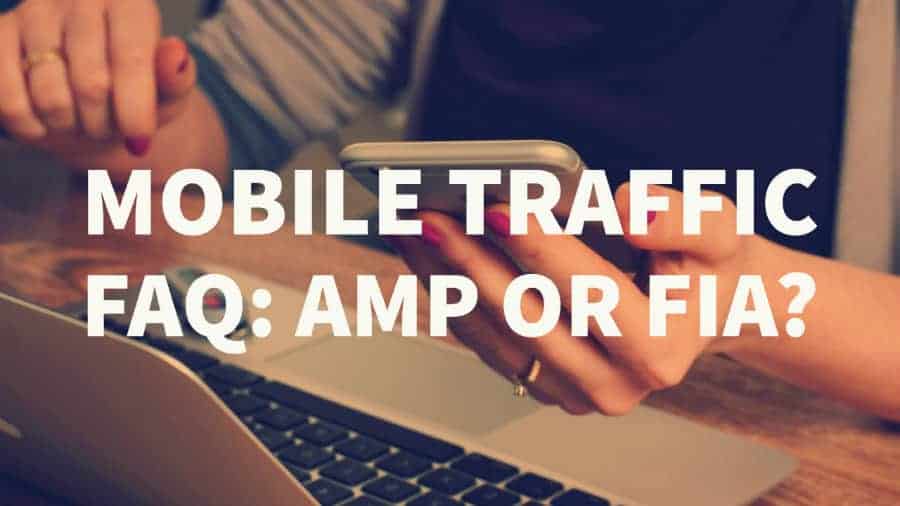
This post was most recently updated on January 18th, 2023
There’s a common misnomer in determining which technology platform to use to serve your mobile traffic. It’s not an either-or proposition. You can run both Google AMP (Accelerated Mobile Pages) and Facebook Instant Articles (IA).
Even if you’re running both, you should still be hosting traditional mobile pages. Your ROI review needs to take a look at how each technology fits your audience profile. Start by asking yourself two questions…
Google AMP only applies to search traffic coming from Google Search and the Chrome news feed on Chrome Mobile. Some publishers get a ton of organic search traffic. Some get very little. Also, Google AMP does not apply to reference content (definitions, encyclopedia entries, translations, etc.).
Google tends not to suggest reference content in their news feed. Also, the block that shows AMP results at the top of Google Search Mobile typically does not show for reference related queries.
Google AMP is also entirely inapplicable for traffic on Facebook and Twitter. So, if you have sufficient organic search traffic to non-reference content, AMP can potentially have ROI for you as a publisher.
How much traffic is “non-negligible”?
You need to review with your dev team, based on your organic traffic reach and content vertical, whether this could have ROI for you. You don’t want to spend the resources developing an AMP compatible version of your site if there’s no chance on ROI.
If you have 10% or higher organic search traffic to non-reference content, we recommend running a test of AMP. Otherwise, we recommend investing your resources elsewhere.
We’ll run through testing procedures below.
Facebook IA only applies to social traffic from Facebook. Some publishers get tons of Facebook social traffic. Some publishers have influencers share popular or feel-good articles on Facebook to maximize reach.
Other publishers have reference content that gets little or no social traction. If you get non-negligible social traffic, you may be interested in testing IA.
Absolutely! AMP only applies to organic Google Search traffic and the Chrome news feed. IA only applies to social traffic from Facebook. Traditional mobile applies to everything else, including Twitter, Reddit, and direct traffic.
In other words, using these technologies are not an either-or scenario. You can run all three. Which technologies you use revolves around understanding the revenue modeling for each. Accelerated mobile technologies like AMP and IA typically reduce page RPM, but the allure is that Google and Facebook claim that they’ll increase your reach on their platforms if you’re compatible with their respective technologies.
In testing, we’ve found this to be beneficial for some publishers, but not others. We’ll run through testing procedures below.
Google AMP has no restrictions on whose demand you can run, so long as the ads themselves function in the AMP environment. However, AMP lazy loads ads by default, causing a drastic drop in impressions per pageview vs. traditional mobile.
AMP does typically increase viewability and CPMs though — the RPMs only suffer because the total impressions fall. We’ve also found that discrepancies for branded impressions can go up on AMP because when the AMP file is served from the Google CDN, they occasionally safe frame ad units.
In contrast, IA prohibits running any ads which are not from Facebook Audience Network or direct sold (see section D.2). Other programmatic ads, including Google Ad Exchange, and header bidding, managed demand, and native/content recommendation networks, are all prohibited on the IA platform.
Although Facebook Audience Network is a top quality ad partner, this often causes a drastic drop in CPM for IA vs. traditional mobile for many publishers.
When doing your financial modeling, you’re looking to see whether the drop in impressions on AMP or the drop in CPMs on IA can be made up for by the increase in reach of each platform.
Unfortunately, it’s impossible to multivariate test each platform because you can’t externally control whether Google sends visitors to your AMP or traditional mobile page while randomizing for accurate multivariate analysis.
Similarly, you can’t control whether Facebook sends visitors randomly to your IA or traditional mobile page while randomizing for a true multivariate test.
So the next best thing is sampling — set up 20 articles on AMP or IA and another 20 articles on traditional mobile, remove the stats for the top and bottom two on each segment (outliers), and compare revenue over some unit time per session coming in for those pages and segments.
Make sure that your promotional efforts of each segment are comparable — if you usually share content through influencers and you’re testing IA, make sure you have influencers share each of the 40 articles similarly.
This will tell you what your typical reach boost is between the platforms so that you can make an informed decision.
After removing the top and bottom 2 from each segment, make sure you pull the number of page views and sessions for each segment. Sessions are necessary because each platform is pitching that they’ll give you more reach if you’re compliant with their tech. More reach should convert to more sessions.
You also want to track the page views to compare pageviews per session to make sure users aren’t abandoning your site in any of the segments.
Ultimately, you’re comparing the revenue per session for AMP vs. traditional mobile, and IA vs. traditional mobile, and looking at what the reach multiplier is on AMP and IA.
If you’re not increasing your reach on AMP or IA, you will want to put those on the back-burner for now. If you need more advice on monetizing your mobile traffic be sure to contact us for a free consultation today!

David Loschiavo is the Chief Product Officer of MonetizeMore. He believes artificial intelligence & machine learning, coupled with technology available to everyone, will change the world for the better and forever.
10X your ad revenue with our award-winning solutions.